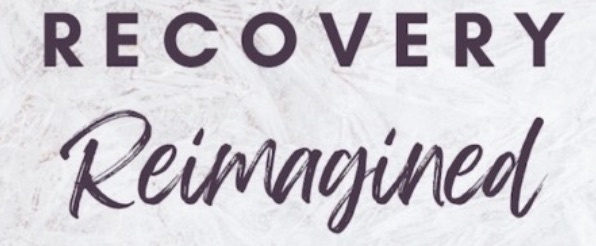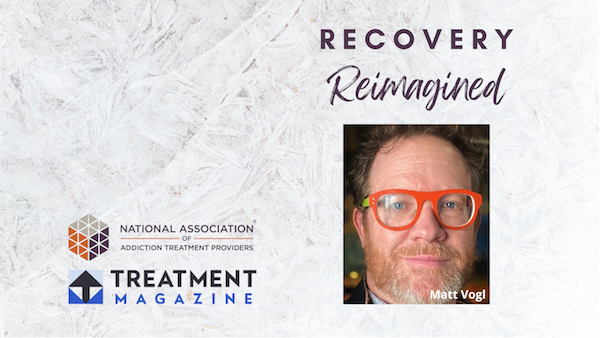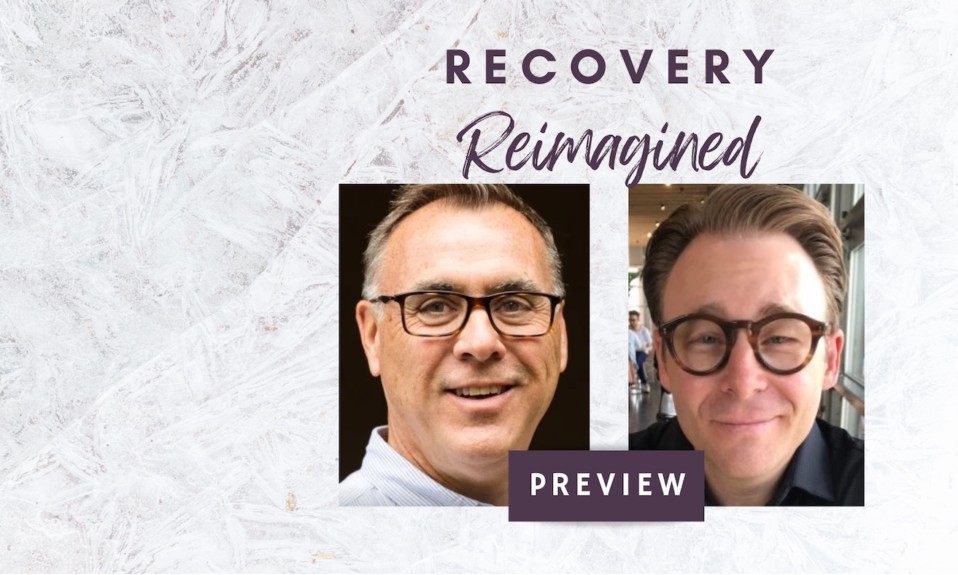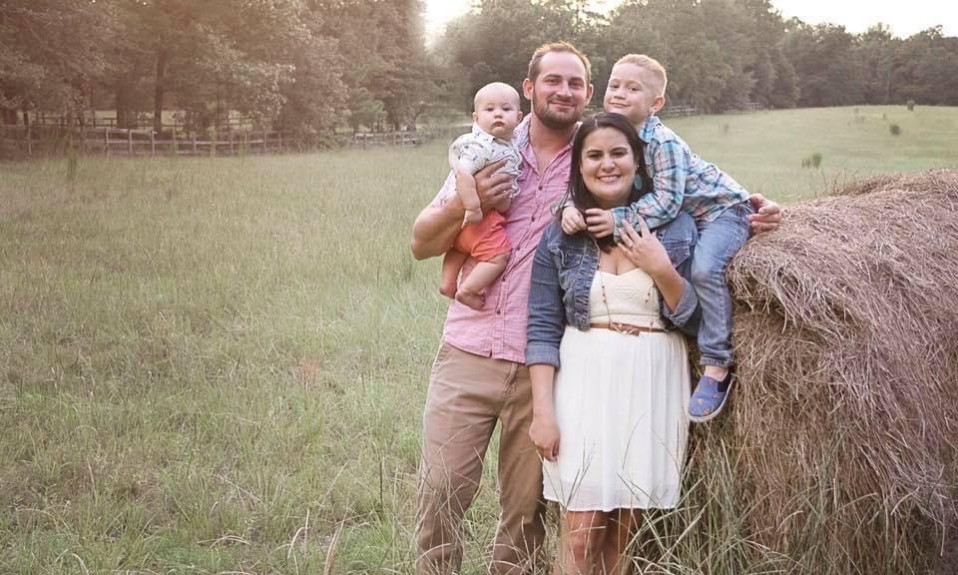Where does technology intersect with addiction and mental health care? The executive director of the National Mental Health Innovation Center gives us some ideas
By Annie Peters, PhD, LP
Editor’s note: In many ways, the future of behavioral health care rests with technology. And Matt Vogl, MPH, is at the forefront of the revolution.
For this second installment of our Recovery Reimagined series, we chat with Vogl, founder and executive director of the National Mental Health Innovation Center (NMHIC) at the University of Colorado Anschutz Medical Campus. Vogl’s mission with the NMHIC is to facilitate the integration of new technologies into mental health treatment. He is something of a pied piper for the role of technology in behavioral health, lecturing internationally and becoming a recognizable figure in the media.

Our interview was conducted by Annie Peters, PhD, LP, director of research and education for the National Association of Addiction Treatment Providers (NAATP). Part of Peters’ work has a technological bent, too. She is the point person for the NAATP’s Foundation for Recovery Science and Education (FoRSE), which is developing a mechanism to produce standardized data for addiction treatment centers.
Recovery Reimagined is a collaboration between the NAATP and TreatmentMagazine.com. The goal for Recovery Reimagined is ambitious: to help improve addiction and mental health outcomes. Through our interviews, we hope to bring new ideas to the fore that will challenge the treatment community to keep striving to do better.
Enjoy reading the following discussion between two professionals who are steeped in the nuances of addiction and mental health treatment.
ANNIE PETERS: I am here today in our ongoing series with TreatmentMagazine.com called Recovery Reimagined. This is our second installment, and today we are talking to Matt Vogl, who is founder and executive director of the National Mental Health Innovation Center.
MATT VOGL: Hi, Annie, thanks for having me here. This is such an honor.
AP: It’s very exciting to have you here. When I think of innovation and digital mental health tools and exciting new changes in this area, I think of you. I’m really glad you could be with us today.
MV: I feel like that’s a bit of an oversell, but I’m flattered anyway, so thank you.
AP: I sent you some questions that we’re asking a number of professionals in behavioral health. We named this series Recovery Reimagined, so when you think about the field of treatment and recovery, what do you think needs to be reimagined?
MV: It’s such a great question. I think what really needs to be reimagined isn’t so much the what—it’s the who, and who’s involved in this. For so long, mental health and addiction have been seen as separate things. Obviously, we talk about dual diagnosis, but even the conferences and the meetings and the professional organizations—we’re all separate. I don’t think we did enough to pull everybody together. When I think about what needs to be reimagined, it’s who do we get under that tent? It’s not just the folks from the treatment and recovery community and mental health. It’s more than that. It’s the tech industry, the pharmaceutical industry, academics, schools and places where prevention needs to happen. Getting everybody together and rallying around a common agenda. Obviously, it’s easy to say and hard to do, but that’s the only way we’re going to see real progress and real change.
AP: Such a good point—make our tent bigger. There are so many brilliant minds in this field and related fields, and if we could get together, we could do a lot more.
MV: You and I are on the planning group for the Global Exchange Conference that’s coming up in November. One of the things I’m so excited about is that they said we need to cover the spectrum—mental health and wellness and addiction treatment and recovery. Why has it taken us this long to make that happen?
AP: Yes, I’m so excited for that conference, especially because it’s at Disney World.
MV: Mouse Land!
AP: What would you say are the most exciting changes, or promising changes, you’ve seen relative to behavioral health and technology?
MV: I think there are two things. One is that there’s a renewed emphasis on prevention. When we look at the problems that we’re having in mental health and in treatment and recovery, it really comes down to one thing, which is capacity. We don’t have enough providers. We don’t have enough centers. We don’t have enough clinicians to take care of the volume of people who are sick. The number of professionals in the field is shrinking, and the number of people who need services is growing. We have this huge problem, and it’s becoming bigger and more problematic by the day.
When you have that supply-and-demand problem and that imbalance in terms of the number of people who can deliver care and the number of people who need it, there’s really only three ways to address that. One is to increase the supply of the providers. That just needs to be off the table, because we can’t just magically say we’re going to set up this factory and build more treatment providers and mental health clinicians. The second way that I think is more realistic is the use of technology—things that can help us extend the workforce and make care more effective, make it more efficient so that people can get better faster.
The third area, which technology can also help with, is prevention. If we keep people from getting sick and from having issues that they need to address with a professional in the first place, that’s going to help with that supply-and-demand problem, because there’s not as many people trying to access the system. I’m excited about the focus on prevention, and I’m really excited, and nervous, about the new focus on technology. Especially coming out of the pandemic, we have investment in the field of mental health and addiction technologies that we’ve never seen before—unprecedented levels from the investment community, from tech companies large and small who are working in this area and coming up with really exciting things.
AP: Can you give some examples?
MV: There’s so much, I don’t even know where to start. Pear Therapeutics was the first app that received FDA approval for a digital therapeutic. Just the fact that the FDA gave approval for an app that went through three phases of clinical trials the same way any drug and device might is really exciting. It means there’s a lot more in the pipeline, things that are going through those early trials right now and are going to be coming to market soon. It’s not just things that you can download from the App Store, but things that clinicians can write prescriptions for and really become powerful clinical tools.
“In our world of mental health, for too long we’ve made ourselves really easy to ignore. People haven’t wanted to come forward, and the stigma is wrapped up in that. People don’t want to out themselves, and I get all that. We have to raise hell.”
—Matt Vogl
Virtual reality is another area—that’s the technology we’re really big on. To some extent, it’s been oversold and overhyped. Dr. Patrick Bordnick, the dean of social work at Tulane, has done really cool work on a research basis, saying, “How can we use VR to create these immersive [drug- and alcohol]-using environments so that people who are going through treatment can practice building refusal skills in a virtual bar or in a virtual party or another using environment?” They’ve done fMRI studies, and the brain really lights up about the same way in these VR experiences as it does if somebody is actually going into a real using environment. They can practice having refusal skills and get the situational confidence that they need, but in an environment where they’re not at risk of losing their sobriety.
AP: And are surrounded by supports.
MV: Exactly. Things like that which have been in the research setting. Now a lot of companies are working on building those and bringing them to the marketplace so that individuals and institutions can have access to them.
AP: Have you seen good prevention technologies?
MV: The most obvious one is in the area of meditation and mindfulness. Mindfulness is nothing new. It has been studied since the dawn of time. We know it’s remarkably effective at all kinds of things with treatment and recovery, but also with people who are doing well, keeping them well and developing that meditation practice. It’s harder to do than just saying it. For a lot of people, they really struggle. I’m one of those people who struggled for a long time to develop my own meditation practice. I’d get two minutes into meditation and get distracted, and then I didn’t realize the benefit. In virtual reality, I can be fully immersed and be on a beach or in some beautiful environment, and it helps me really stay focused. I’ve been able to develop my own consistent meditation practice, really for the first time. I don’t think that any one technology or any one approach is going to get people there. Now people have so many options—apps and things. There’s really, truly now something for everybody.
AP: You make a good point about meditation with respect to prevention. If young people learn to meditate or learn mindfulness or some basic emotion regulation skills in a fun way using technology, before going into their teens and being around triggers and substances, might that have an impact? Because addiction is the opposite of mindfulness.
MV: There’s so much being made right now about the high rates of anxiety with kids. We’re hearing that all the time, and kids don’t have tools to deal with their anxiety. Anybody who’s been through a panic attack—it’s horrible. It’s no surprise that kids turn to substances. Things are readily available, access to weed like we have here in Colorado. The stuff is out there and so easy to get. If kids say that this helps numb it and helps me feel better with anxiety, they’re going to choose that. If we can give them a practice early on to help them deal with that anxiety, maybe they’re going to choose that instead.
AP: What change in the healthcare system do you think would make a big impact?
MV: One of the biggest changes is we need to figure out how to pay for these things. That’s what’s lagging right now in mental health technology. You have apps that are going through the FDA approval process. There are really three groups involved in the development of these technologies, and they’re all going at different speeds. The tech industry, which is making stuff really fast and bringing it to market. Then you have the FDA; they’ve recognized that they need to keep up, and they’re scrambling to do that, but at least they’re involved in the game. Then you have the policymakers who determine what can get billed for and what are the reimbursement mechanisms and codes. That’s where we’re lagging behind. Ultimately, it’s going to create a disincentive to the extent that will stifle development. Who’s going to want to create something if there’s not a market for it?
AP: It’s such a good point because the FDA relies on research, and research is very slow. And technology is very fast. We’re going to get these tools more quickly and in the hands of kids and adults and people with different mental health and substance use disorders. We don’t know much about how they work, but in order to get them paid for, it takes that slow process. It doesn’t happen at the speed of technology.
MV: It forces companies into this hard decision where they say, “Okay, we’ve spent all these resources developing this thing. If we can’t get reimbursed for it, and if we can’t bring it to market and make a profit, then we’re going to have to try to sell it anyway. Then our focus is not going to be on the science and proving its efficacy, but it’s going to be all on marketing.” It leads companies to make some pretty dangerous, bogus claims about what their products can and can’t do that really aren’t supported by sound science. They’re bypassing that, because if we can’t go the FDA scientific route, there’s not money in it. “Why would we do that? Let’s pour money into marketing and sell the sizzle instead of the steak.” We can’t let that happen.
“It’s a double-edged sword, because technology is really good at connecting people and also really good at isolating people. We have to figure out how we reconcile those two things and leverage the good.”
—Matt Vogl
AP: What are the steps to get us there? What’s in the way?
MV: It goes back to the first question you asked. We need more people under the tent. It’s a recognition that no one entity—no one group of professionals or people or consumers, the tech industry—nobody can do it alone. We have to figure out how we get all of those siloed sectors speaking with one another. How we do that beats the hell out of me. We have to find ways. It starts with events like the Global Exchange. Getting exposure to the others that are in the same fight and fighting alongside them. Any time there’s been a revolution in our country, which is really what we need right now, it all starts with individual people who are fed up making a lot of noise.
Things stay the same because people make it easy for them to stay the same. Whether it’s voting rights or changes in policies. Throughout the history of our country, when there’s change that needs to be made, it’s when people rise up. Look at Black Lives Matter. We need some people to be rebellious and to demand change, to make phone calls, to write letters and emails and to say that to the people who hold the purse strings. “Enough—we’re not going to take this anymore.” In our world of mental health, for too long we’ve made ourselves really easy to ignore. People haven’t wanted to come forward, and the stigma is wrapped up in that. People don’t want to out themselves, and I get all that. We have to raise hell.
AP: We need a revolution in behavioral health, and technology is one of the ways to get us there. We can harness those tools to make some big changes. When we’re looking at payment, how do you get expensive technologies out to people who need them but don’t have resources? For people who don’t have a lot of resources, if things aren’t paid for or aren’t reimbursed, they’re not going to get that experience.
MV: We have to tailor our message more than we do now. In our world, we’ve always just said, “You should give more resources,” or, “You should help more people because it’s the right thing to do.” Yeah, it’s the right thing to do, but that’s not what going to lead to change. When you say that, it doesn’t speak to, “How does this affect me personally?” Schools are struggling with not being able to meet the needs of students with respect to the mental health and SUD [substance use disorder] issues.
By putting more resources into prevention, your teachers are going to have better classroom experiences. The kids are going to learn better. You’re going to have better retention of the teachers. Saying to the policymakers, regardless of whether you think this is the right thing or not, “Financially this is the right thing to do, and here’s the payoff.” Give them that data. Look at every single group. Go to employers and say, “Okay, turnover is incredibly costly, as is workplace absenteeism and presenteeism. Mental health and substance use disorders are two of the biggest drivers of those things. A smart business decision is to take your head out of the sand and focus on these things. Tackle it head-on.” Tailor the message for whatever group, get every constituency involved and into that tent.
AP: Thank you so much, Matt. This has been a really exciting conversation. Anything else that’s specific to substance use recovery technology that you’ve seen?
MV: There’s a lot happening in the space of app-based peer support, and even now VR-based peer support. Having people that you can turn to, that you can lean on when you’re struggling, is incredibly important. For some people, depending on where they’re living or where they work, accessing that kind of network in person can be a challenge. If you can do some of those things through apps, you cast a much wider net. The odds of finding someone that really gets your situation and has been through something similar is much greater if you’re able to look across the whole country, or the whole world.
The other thing—and this is probably a subject for a whole other interview—is if are there technology equivalents to what is being promised with the advances in psychedelics. That’s going to be a really challenging thing, because you have psilocybin and MDMA that are steaming full speed toward FDA approval. They’re also drugs with high abuse potential, and we have to be so careful. On the one hand, it could be the most revolutionary breakthrough in mental health treatment that we’ve seen in our lifetimes. On the other hand, it’s opening the door for a whole new wave of abuse and addiction. How do you reconcile those things? There are people already working on it. We can mimic some of those experiences, or at least elements of some of those experiences, using VR, using apps.
AP: That’s a really interesting question—what’s the tech equivalent of psychedelics?
MV: We’re going to need to look at that because it’s about to become a really huge issue that we’re going to have to figure out.
AP: We also hear that the opposite of addiction is connection. Addiction is about isolation, and recovery is about connection. One thing technology is good at is connecting people. It’s different, but there’s a lot of value and promise there.
MV: It’s a double-edged sword, because technology is really good at connecting people and also really good at isolating people. We have to figure out how we reconcile those two things and leverage the good.
Read our previous Recovery Reimagined interview, with John Kelly, PhD, LP, founder of the Recovery Research Institute at Massachusetts General Hospital.














